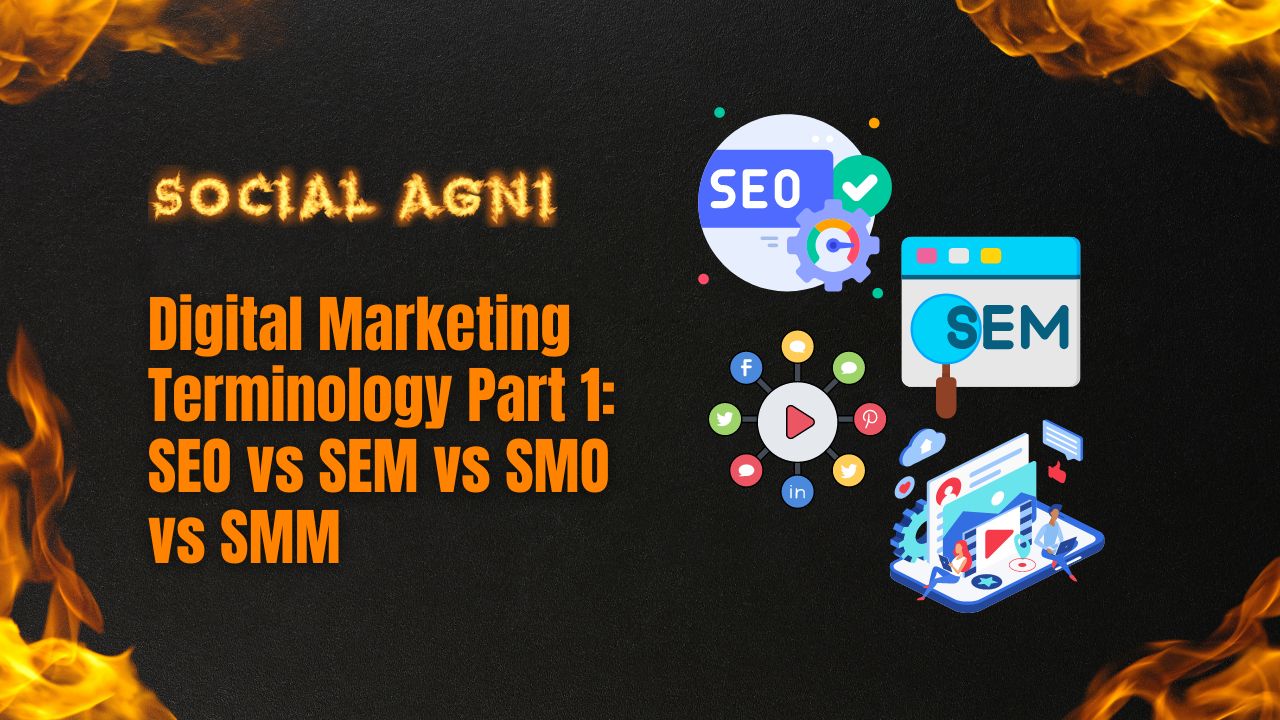Understanding digital marketing terminology is essential in today’s digital world, where firms flourish online. SEO, SEM, SMO, and SMM are frequently discussed. This post will explain these concepts and how they fit into a digital marketing plan. SEO optimize websites for search engine result pages (SERPs). SEO uses keyword optimization, quality content, and link building to increase organic (unpaid) website traffic. SEO’s ultimate objective is to boost a website’s reputation and authority, increasing exposure and conversion rates. SEM promotes websites through paid search engine advertising. SEM uses Google advertising to display advertising at the top of search results, luring customers. SEM works well for time-sensitive campaigns or new firms that need instant visibility, unlike SEO, which focuses on long-term organic development. SMO boosts a brand’s social media presence. SMO encompasses social media optimization, content creation, and audience engagement. SMO helps firms enhance brand loyalty, online traffic, and reach. SMM supplements SMO with paid social media advertising. SMM helps businesses reach more people and increase website traffic by targeting certain demographics, interests, and behaviors. SMM campaigns provide firms with flexible marketing alternatives including image advertisements, video ads, and sponsored posts. Digital marketers and company owners must understand these phrases and distinctions. Businesses may boost their online visibility, attract appropriate audiences, and produce leads and conversions with efficient SEO, SEM, SMO, and SMM tactics. We’ll examine these digital marketing terminology’s essential principles, strategies, and contrasts in the following parts. You can create an effective digital marketing strategy for your organization by mastering SEO, SEM, SMO, and SMM. 1. Search Engine Optimization (SEO) A. Definition and Goal SEO optimizes websites for search engine result pages (SERPs). It entails using several methods to increase search engine organic traffic. SEO boosts website credibility, authority, and relevance, increasing exposure, organic traffic, and conversions. B. Fundamentals 1. On-Page SEO On-page SEO optimizes website features to boost search engine rankings. Key methods: Keyword Optimisation: Researching keywords and strategically inserting them in titles, headers, meta descriptions, and content. Quality Content Creation: Writing useful, interesting, and keyword-rich content for the intended audience. Website Structure and Navigation: Optimising internal linking, user-friendly URLs, and website organization. UX/Mobile Optimisation: Optimising website performance, mobile responsiveness, and user-friendly design for a smooth user experience. 2. Off-Page SEO Off-page SEO optimizes external elements to boost search engine ranks. Key methods: Link building: Acquiring high-quality backlinks from authoritative websites to show search engines the website’s reputation and significance. Social Signals: Sharing, liking, and commenting on social media to show the website’s popularity and relevancy. Online Reputation Management: Monitoring and managing online reviews, testimonials, and mentions to develop a good reputation. C. SEO vs SEM Search Engine Marketing (SEM) employs both organic and paid methods to boost website presence on search engines, unlike SEO. SEM encompasses SEO and PPC marketing. SEM can boost exposure immediately, but SEO needs regular optimization and work. Search engine marketing works best when SEO and SEM are balanced. Businesses may succeed in search marketing by combining SEO’s long-term advantages with SEM’s instant results. 2. Search Engine Marketing (SEM) A. Definition and Goal SEM is the sponsored promotion of websites on search engine result pages (SERPs). SEM uses sponsored advertisements like Google Ads to target potential buyers. SEM boosts business exposure, traffic, and conversions. B. Fundamentals 1. Selecting Keywords SEM requires keyword research. It entails choosing keywords that potential buyers could use to find items or services. Keyword research methods: Keyword Analysis: Using Google Keyword Planner or SEMrush to analyze keyword search volume, competitiveness, and relevance. Long-Tail Keywords: Targeting highly tailored keyword phrases. Negative Keywords: Eliminating business-unrelated keywords to maximize marketing budget and reach. 2. Advertising and Campaign Management Success requires appealing advertising and SEM campaign management. Key methods: Ad Formats and Extensions: Selecting text, picture, or video advertising and using site links or call extensions to give more information and boost ad visibility. Ad text Optimisation: Writing attractive ad text that attracts customers, showcases unique selling propositions, and incorporates relevant keywords. Ad Targeting: Reaching the right audience using demographics, geography, interests, and device kinds. Bidding Techniques and Budget Management: Optimising ROI by using cost-per-click or cost-per-impression bidding techniques and budget management. C. SEM vs SEO SEM and SEO both boost search engine exposure, although they differ in key ways: Speed and Results: SEM advertisements appear instantaneously, but SEO takes time to optimize and enhance organic ranks. Cost: SEM’s cost-per-click or impression model requires a budget for ad campaigns, whereas SEO’s organic tactics don’t. Placement: SEM advertisements appear above organic search results as “Ads,” whereas SEO focuses on organic search results. Strategy: SEM is good for time-sensitive campaigns, promotions, and firms seeking rapid awareness, whereas SEO is good for long-term organic development. Search marketing requires SEM and SEO integration. Businesses may create a well-rounded digital marketing plan by combining SEM’s quick visibility with SEO’s long-term benefits. 3. Social Media Optimization (SMO) A. Definition and Goal SMO involves optimizing social media accounts, content, and tactics to boost brand visibility, engagement, and reach. SMO helps brands engage with their target audience, establish brand loyalty, and increase website traffic. B. Fundamentals 1. Optimising Profile SMO requires optimizing social media accounts. Key methods: Keyword Optimisation: Using relevant keywords in usernames, descriptions, and hashtags to increase searchability and discoverability. Consistent Branding: Maintaining logos, colors, and messaging throughout social media platforms. Completeness and Relevance: Updating website links, contact information, and business descriptions in all profile areas. Visual Appeal: Using high-quality photographs, cover shots, and profile pictures that match the brand and engage with the target demographic. 2. Strategic Content Curation SMO requires a good content strategy. Key methods: Engaging Content Creation: Creating high-quality, engaging posts, photos, videos, and infographics that engage the target audience. Content Scheduling and Frequency: Using platform algorithms and audience behavior to determine the best publishing schedule and update frequency. Hashtag Optimisation: Using popular hashtags to boost content discoverability and audience reach. Social listening: Monitoring brand mentions, comments, and debates on social media and engaging with the audience. C. SMO vs SEO vs SEM In digital
